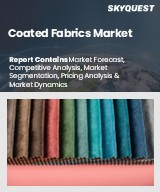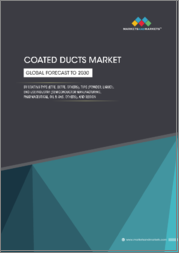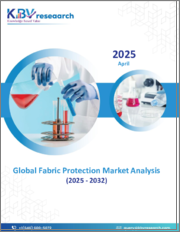
|
시장보고서
상품코드
1511274
세계의 원단 보호 시장 : 유형별, 용도별, 지역별 분석 및 예측(-2030년)Fabric Protection Market Forecasts to 2030 - Global Analysis By Type (Stain Protection, Water Repellent, UV Protection, Anti-Microbial, Flame Retardant and Other Types), Application and By Geography |
||||||
Stratistics MRC에 따르면 세계 원단 보호 시장은 2024년에 16억 달러를 차지하고 예측 기간 중 복합 연간 성장률(CAGR)은 6.6%를 나타낼 전망이며, 2030년에는 23억 달러에 이를 전망입니다. 직물 보호는 섬유 제품에 특수 가공 및 코팅을 적용하여 내구성과 다양한 유형의 손상에 대한 저항력을 높이는 것입니다. 이러한 보호 수단은 먼지, 물, 자외선, 마모와 같은 일반적인 위협으로부터 섬유를 보호합니다. 패브릭 프로텍터는 일반적으로 재료의 표면에 장벽을 형성하고 액체를 튀기고 섬유에 스며들지 않도록 합니다. 또한 곰팡이, 흰 곰팡이, 박테리아의 번식을 억제하고, 반죽의 수명을 연장하고, 외관을 유지하는 첨가제가 포함되어있을 수 있습니다.
Journal of Textile Science and Engineering에 따르면, 섬유 보호 제품은 섬유 제품의 내구성과 성능을 크게 향상시키고, 빈번한 교체 필요성을 줄이고 지속가능한 소비 패턴에 기여할 수 있습니다.
가처분 소득 증가와 야외 활동의 중시
가처분 소득이 증가함에 따라 소비자는 고품질 아웃도어웨어 및 기어에 더 많은 투자를 할 수 있게 되었습니다. 사람들이 하이킹, 캠프, 스포츠 등 야외 활동에 종사함에 따라 내구성, 내수성, 발오성을 강화한 섬유에 대한 수요가 높아지고 있습니다. 직물 보호 가공은 이러한 바람직한 기능을 제공하여 처리된 아웃도어 의류와 기어를 소비자에게 보다 매력적으로 만들고 시장 성장을 가속하고 있습니다.
제한된 인식과 인지
독성, 환경에 미치는 영향, 효과에 대한 우려 등 섬유 보호 가공에 대한 부정적인 인식은 소비자가 가공된 섬유 제품을 채택하는 것을 망설일 수 있습니다. 또한 소비자가 반죽 보호 가공을 효과적이지 않거나 유해하다고 인식하면 이러한 제품을 제공하는 브랜드의 명성이 떨어질 수 있습니다. 이러한 패브릭 보호 솔루션에 대한 소극적인 자세는 시장 침투를 방해하고 혁신적인 기술의 채용을 제한할 수 있습니다.
가정용 가구와 실내 장식 프로젝트의 급증
가정용 가구는 특히 거실이나 식당과 같은 사람의 출입이 많은 곳에서는 항상 마모와 파손에 노출되어 있습니다. 패브릭 보호 가공은 액체를 튕겨 먼지와 잦은 패브릭에 침투하는 것을 방지하는 보호 장벽을 만들어 유지 보수 노력을 줄이고 가구의 미관을 유지합니다. 또한 제조업체는 가정용 가구 시장의 소비자의 다양한 요구를 충족시키기 위해 의자, 커튼, 야외 가구 등 특정 용도에 특화된 처방을 개발할 수 있습니다.
특정 화학물질이 환경에 미치는 영향
환경 문제에 대한 의식이 높아지면 소비자는 직물 보호 가공에 사용되는 성분을 음미하게 되었습니다. 정부와 규제 기관은 환경과 건강에 해로운 소비자 제품에 특정 화학 물질의 사용을 제한하는 움직임을 강화하고 있습니다. 불소계 화합물(PFAS 등)과 같이 환경에 유해한 것으로 인식되는 화학물질은 소비자의 저항으로 이어져 처리된 섬유제품의 구입에 소극적으로 되어 시장 수요가 감소합니다. 가능성이 있습니다.
COVID - 19의 영향
위생 의식 증가와 청결에 대한 우려로, 특히 의료, 접객, 주택 청소 등의 부문에서 섬유 보호 가공에 대한 수요가 증가하고 있습니다. 소비자는 박테리아 감염의 위험을 줄이기 위해 항균 특성을 가진 섬유 제품을 찾고 있습니다. 소비자의 구매력 저하, 소매점의 일시적인 폐쇄, 불필요한 급한 지출의 연기로 인해 일부 부문에서는 반죽 보호 가공에 대한 수요가 감소하고 있습니다.
예측 기간 동안 방오 가공 부문이 최대가 될 전망입니다.
방오 가공에 의해 제조업체와 브랜드는 경쟁사와의 차별화를 도모하고 경쟁을 높일 수 있기 때문에 방오 가공 부문은 유리한 성장을 이룰 것으로 추정됩니다. 첨단 방오 기술로 가공된 직물은 액체를 튀기고 더러워지며 장기간에 걸쳐 외관을 유지할 수 있기 때문에 시장에서 두드러집니다. 이 차별화를 통해 제조업체는 품질, 성능 및 관리의 용이성을 선호하는 눈부신 소비자를 끌어들일 수 있습니다.
가재도구 부문은 예측기간 중 가장 높은 복합 연간 성장률(CAGR)이 예상된다.
가재 도구 부문은 예측 기간 동안 가장 높은 복합 연간 성장률(CAGR) 성장이 예상됩니다. 소비자들에게 가정용 가구는 엄청난 투자이며, 소비자들은 이러한 구매품에 내구성과 긴 수명을 기대합니다. 패브릭 보호 가공은 얼룩, 먹기, 퇴색, 마모로부터 가구를 보호함으로써 부가 가치를 제공하고 장기간에 걸쳐 외관과 기능을 유지합니다. 그 결과, 소비자는 강화된 보호와 안심감을 제공하는 가공된 섬유에 비싼 가격을 지불하는 것을 괴롭히지 않습니다.
최대 점유율을 차지하는 지역 :
아시아태평양은 특히 중국, 인도, 동남아시아 국가 등의 급속한 도시화가 가정용 가구, 의자장, 의류 수요 증가로 이어지고 있기 때문에 예측기간 동안 최대 시장 점유율을 차지할 것으로 예측됩니다. 도시 인구가 증가함에 따라 도시 생활 환경에서 이러한 섬유 제품의 외관과 수명을 유지하기위한 직물 보호 가공 수요도 증가하고 있습니다.
복합 연간 성장률(CAGR)이 가장 높은 지역 :
북미의 원단 보호 가공업체는 새로운 배합, 기술, 도포방법을 개발하기 위해 지속적으로 기술 혁신을 하고 있기 때문에 예측기간 중 복합 연간 성장률(CAGR)은 북미의가 가장 높을 것으로 예측됩니다. 첨단 가공은 방오성, 발수성, UV 차단, 통기성을 강화하고 소비자에게 특정 요구를 충족시키는 다양한 옵션을 제공합니다.
무료 사용자 정의 서비스 :
이 보고서를 구독하는 고객은 다음 무료 맞춤설정 옵션 중 하나를 사용할 수 있습니다.
- 기업 프로파일
- 추가 시장 진출기업의 종합적 프로파일링(3개사까지)
- 주요 기업의 SWOT 분석(3개사까지)
- 지역 세분화
- 고객의 관심에 응한 주요국 시장 추정,예측,복합 연간 성장률(CAGR)(주 : 타당성 확인에 따름)
- 경쟁 벤치마킹
- 제품 포트폴리오, 지리적 존재, 전략적 제휴별 주요 기업 벤치마킹
목차
제1장 주요 요약
제2장 서문
- 개요
- 이해관계자
- 조사 범위
- 조사 방법
- 데이터 마이닝
- 데이터 분석
- 데이터 검증
- 조사 접근
- 조사 정보원
- 1차 조사 정보원
- 2차 조사 정보원
- 전제조건
제3장 시장 동향 분석
- 소개
- 성장 촉진요인
- 억제요인
- 기회
- 위협
- 용도 분석
- 신흥 시장
- COVID - 19의 영향
제4장 Porter's Five Forces 분석
- 공급기업의 협상력
- 구매자의 협상력
- 대체품의 위협
- 신규 진입업자의 위협
- 경쟁 기업간 경쟁 관계
제5장 세계 원단 보호 시장 : 유형별
- 소개
- 방오
- 발수제
- UV 보호
- 항균
- 난연제
- 기타
제6장 세계 원단 보호 시장 : 용도별
- 소개
- 가재 도구
- 옷
- 자동차
- 의료
- 산업
- 내장재
- 기타
제7장 세계 원단 보호 시장 : 지역별
- 소개
- 북미
- 미국
- 캐나다
- 멕시코
- 유럽
- 독일
- 영국
- 이탈리아
- 프랑스
- 스페인
- 기타 유럽
- 아시아태평양
- 일본
- 중국
- 인도
- 호주
- 뉴질랜드
- 한국
- 기타 아시아태평양
- 남미
- 아르헨티나
- 브라질
- 칠레
- 기타 남미
- 중동 및 아프리카
- 사우디아라비아
- 아랍에미리트(UAE)
- 카타르
- 남아프리카
- 기타 중동 및 아프리카
제8장 주요 개발
- 계약/파트너십/협업/합작투자(JV)
- 인수와 합병
- 신제품 발매
- 사업 확대
- 기타 주요 전략
제9장 기업 프로파일링
- Alicorp SAA
- Amway Corporation
- Church & Dwight Co., Inc
- Fabrica de Jabon La Corona
- Golrang Industrial Group
- Guangzhou Libby Enterprise Group Co., Ltd.
- Henkel AG & Co. KGaA
- Johnson & Son Inc.
- Kao Corporation
- LG Household & Health Care Ltd.
- Lion Corporation
- Nice Group Co., Ltd.
- Procter & Gamble Co.
- Reckitt Benckiser Group PLC
- RSPL Limited
- SA de CV
- Unilever PLC
- Whealthfields Lohmann Guangzhou Ltd.
According to Stratistics MRC, the Global Fabric Protection Market is accounted for $1.6 billion in 2024 and is expected to reach $2.3 billion by 2030 growing at a CAGR of 6.6% during the forecast period. Fabric protection is the application of specialized treatments or coatings to textiles to enhance their durability and resistance to various types of damage. These protective measures guard fabrics against common threats such as stains, water, UV radiation, and abrasion. Fabric protectors typically work by forming a barrier on the surface of the material, repelling liquids and preventing them from soaking into the fibers. They may also include additives that inhibit the growth of mold, mildew, and bacteria, prolonging the fabric's lifespan and maintaining its appearance.
According to Journal of Textile Science and Engineering, fabric protection products can significantly improve the durability and performance of textiles, reducing the need for frequent replacement and contributing to sustainable consumption patterns.
Market Dynamics:
Driver:
Rising disposable income and focus on outdoor activities
Rising disposable incomes enable consumers to invest more in high-quality outdoor apparel and gear. As people engage in outdoor activities such as hiking, camping, and sports, there is a greater demand for textiles with enhanced durability, water resistance, and stain repellency. Fabric protection treatments provide these desired features, making treated outdoor apparel and gear more appealing to consumers thus encouraging the growth of the market.
Restraint:
Limited awareness and perception
Negative perceptions about fabric protection, such as concerns about toxicity, environmental impact, or effectiveness, can deter consumers from adopting treated textiles. Moreover if consumers perceive fabric protection treatments as ineffective or harmful, it can damage the reputation of brands that offer these products. This reluctance to embrace fabric protection solutions can hinder market penetration and limit the adoption of innovative technologies.
Opportunity:
Surge in home furnishing and interior decor projects
Home furnishings are subjected to constant wear and tear, particularly in high-traffic areas such as living rooms and dining areas. Fabric protection treatments create a protective barrier that repels liquids and prevents dirt and grime from penetrating the fabric, thereby reducing maintenance efforts and preserving the aesthetic appeal of furnishings. Additionally manufacturers can develop specialized formulations for specific applications, such as upholstery, drapery, or outdoor furniture, to meet the diverse needs of consumers in the home furnishing market.
Threat:
Environmental impact of certain chemicals
Growing awareness of environmental issues prompts consumers to scrutinize the ingredients used in fabric protection treatments. Governments and regulatory agencies are increasingly implementing restrictions on the use of certain chemicals in consumer products due to their environmental and health hazards. Chemicals that are perceived as harmful to the environment, such as fluorinated compounds (e.g., PFAS), can lead to consumer resistance and reluctance to purchase treated textiles, thereby reducing market demand.
Covid-19 Impact
Heightened hygiene awareness and concerns about cleanliness have increased the demand for fabric protection treatments, particularly in sectors such as healthcare, hospitality, and residential cleaning. Consumers are seeking textiles with antimicrobial properties to reduce the risk of germ transmission. Reduced consumer purchasing power, temporary closures of retail outlets and postponement of non-essential spending have dampened demand for fabric protection treatments in some sectors.
The stain protection segment is expected to be the largest during the forecast period
The stain protection segment is estimated to have a lucrative growth, as stain protection gives manufacturers and brands a competitive edge by differentiating their products from competitors. Fabrics treated with advanced stain protection technologies stand out in the market for their ability to repel liquids, resist staining, and maintain their appearance over time. This differentiation helps manufacturers attract discerning consumers who prioritize quality, performance, and ease of care.
The home furnishings segment is expected to have the highest CAGR during the forecast period
The home furnishings segment is anticipated to witness the highest CAGR growth during the forecast period, home furnishings are substantial investments for consumers, and they expect durability and longevity from these purchases. Fabric protection treatments offer added value by safeguarding furnishings against stains, spills, fading, and wear, thus preserving their appearance and functionality over time. As a result, consumers are willing to pay a premium for treated textiles that offer enhanced protection and peace of mind.
Region with largest share:
Asia Pacific is projected to hold the largest market share during the forecast period owing to the region's rapid urbanization, particularly in countries such as China, India, and Southeast Asian nations, is leading to increased demand for home furnishings, upholstery, and apparel. As urban populations grow, so does the demand for fabric protection treatments to maintain the appearance and longevity of these textiles in urban living environments.
Region with highest CAGR:
North America is projected to have the highest CAGR over the forecast period, owing to fabric protection manufacturers in North America are continuously innovating to develop new formulations, technologies, and application methods. Advanced treatments offer enhanced stain resistance, water repellency, UV protection, and breathability, providing consumers with a wide range of options to meet their specific needs.
Key players in the market
Some of the key players in the Fabric Protection Market include Alicorp S.A.A, Amway Corporation, Church & Dwight Co., Inc, Fabrica de Jabon La Corona, Golrang Industrial Group, Guangzhou Libby Enterprise Group Co., Ltd., Henkel AG & Co. KGaA, Johnson & Son Inc., Kao Corporation, LG Household & Health Care Ltd., Lion Corporation, Nice Group Co., Ltd., Procter & Gamble Co., Reckitt Benckiser Group PLC, RSPL Limited, SA de CV, Unilever PLC and Whealthfields Lohmann Guangzhou Ltd.
Key Developments:
In May 2024, Henkel delivers strong organic sales growth in the first quarter. In nominal terms, sales were down -5.2 percent compared to the prior-year quarter - predominantly due to the sale of the business activities in Russia and to negative foreign exchange effects.
In November 2023, New Amway eSpring(TM) Water Purifier uses industry-leading UV-C LED technology to treat water. The launch marks the first complete eSpring product re-design in more than 20 years. eSpring is the world's number-one selling brand of home water treatment systems.
In October 2023, Alicorp and Auna will provide free tests to female leaders. The purpose of Pots that Develop is to contribute to the maintenance of common pots through training on management, nutrition, entrepreneurship and other topics for their leaders.
Types Covered:
- Stain Protection
- Water Repellent
- UV Protection
- Anti-Microbial
- Flame Retardant
- Other Types
Applications Covered:
- Home Furnishings
- Apparel
- Automotive
- Healthcare
- Industrial
- Upholstery
- Other Applications
Regions Covered:
- North America
- US
- Canada
- Mexico
- Europe
- Germany
- UK
- Italy
- France
- Spain
- Rest of Europe
- Asia Pacific
- Japan
- China
- India
- Australia
- New Zealand
- South Korea
- Rest of Asia Pacific
- South America
- Argentina
- Brazil
- Chile
- Rest of South America
- Middle East & Africa
- Saudi Arabia
- UAE
- Qatar
- South Africa
- Rest of Middle East & Africa
What our report offers:
- Market share assessments for the regional and country-level segments
- Strategic recommendations for the new entrants
- Covers Market data for the years 2022, 2023, 2024, 2026, and 2030
- Market Trends (Drivers, Constraints, Opportunities, Threats, Challenges, Investment Opportunities, and recommendations)
- Strategic recommendations in key business segments based on the market estimations
- Competitive landscaping mapping the key common trends
- Company profiling with detailed strategies, financials, and recent developments
- Supply chain trends mapping the latest technological advancements
Free Customization Offerings:
All the customers of this report will be entitled to receive one of the following free customization options:
- Company Profiling
- Comprehensive profiling of additional market players (up to 3)
- SWOT Analysis of key players (up to 3)
- Regional Segmentation
- Market estimations, Forecasts and CAGR of any prominent country as per the client's interest (Note: Depends on feasibility check)
- Competitive Benchmarking
- Benchmarking of key players based on product portfolio, geographical presence, and strategic alliances
Table of Contents
1 Executive Summary
2 Preface
- 2.1 Abstract
- 2.2 Stake Holders
- 2.3 Research Scope
- 2.4 Research Methodology
- 2.4.1 Data Mining
- 2.4.2 Data Analysis
- 2.4.3 Data Validation
- 2.4.4 Research Approach
- 2.5 Research Sources
- 2.5.1 Primary Research Sources
- 2.5.2 Secondary Research Sources
- 2.5.3 Assumptions
3 Market Trend Analysis
- 3.1 Introduction
- 3.2 Drivers
- 3.3 Restraints
- 3.4 Opportunities
- 3.5 Threats
- 3.6 Application Analysis
- 3.7 Emerging Markets
- 3.8 Impact of Covid-19
4 Porters Five Force Analysis
- 4.1 Bargaining power of suppliers
- 4.2 Bargaining power of buyers
- 4.3 Threat of substitutes
- 4.4 Threat of new entrants
- 4.5 Competitive rivalry
5 Global Fabric Protection Market, By Type
- 5.1 Introduction
- 5.2 Stain Protection
- 5.3 Water Repellent
- 5.4 UV Protection
- 5.5 Anti-Microbial
- 5.6 Flame Retardant
- 5.7 Other Types
6 Global Fabric Protection Market, By Application
- 6.1 Introduction
- 6.2 Home Furnishings
- 6.3 Apparel
- 6.4 Automotive
- 6.5 Healthcare
- 6.6 Industrial
- 6.7 Upholstery
- 6.8 Other Applications
7 Global Fabric Protection Market, By Geography
- 7.1 Introduction
- 7.2 North America
- 7.2.1 US
- 7.2.2 Canada
- 7.2.3 Mexico
- 7.3 Europe
- 7.3.1 Germany
- 7.3.2 UK
- 7.3.3 Italy
- 7.3.4 France
- 7.3.5 Spain
- 7.3.6 Rest of Europe
- 7.4 Asia Pacific
- 7.4.1 Japan
- 7.4.2 China
- 7.4.3 India
- 7.4.4 Australia
- 7.4.5 New Zealand
- 7.4.6 South Korea
- 7.4.7 Rest of Asia Pacific
- 7.5 South America
- 7.5.1 Argentina
- 7.5.2 Brazil
- 7.5.3 Chile
- 7.5.4 Rest of South America
- 7.6 Middle East & Africa
- 7.6.1 Saudi Arabia
- 7.6.2 UAE
- 7.6.3 Qatar
- 7.6.4 South Africa
- 7.6.5 Rest of Middle East & Africa
8 Key Developments
- 8.1 Agreements, Partnerships, Collaborations and Joint Ventures
- 8.2 Acquisitions & Mergers
- 8.3 New Product Launch
- 8.4 Expansions
- 8.5 Other Key Strategies
9 Company Profiling
- 9.1 Alicorp S.A.A
- 9.2 Amway Corporation
- 9.3 Church & Dwight Co., Inc
- 9.4 Fabrica de Jabon La Corona
- 9.5 Golrang Industrial Group
- 9.6 Guangzhou Libby Enterprise Group Co., Ltd.
- 9.7 Henkel AG & Co. KGaA
- 9.8 Johnson & Son Inc.
- 9.9 Kao Corporation
- 9.10 LG Household & Health Care Ltd.
- 9.11 Lion Corporation
- 9.12 Nice Group Co., Ltd.
- 9.13 Procter & Gamble Co.
- 9.14 Reckitt Benckiser Group PLC
- 9.15 RSPL Limited
- 9.16 SA de CV
- 9.17 Unilever PLC
- 9.18 Whealthfields Lohmann Guangzhou Ltd.



















